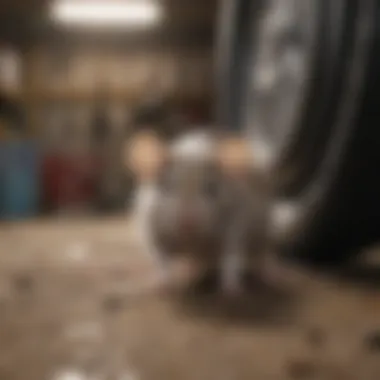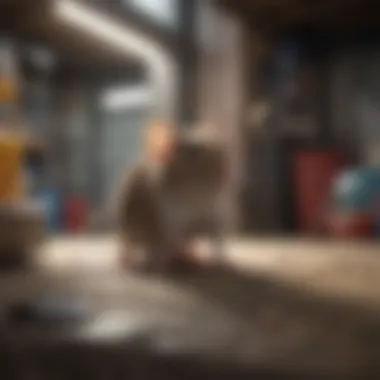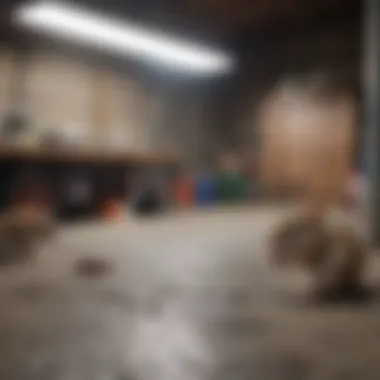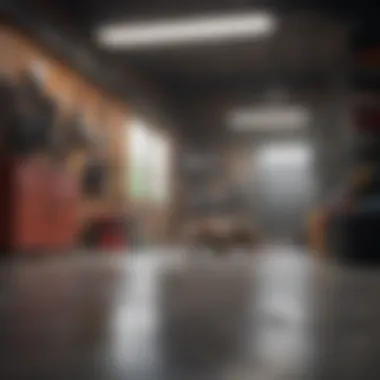Effective Strategies for Eliminating Mice in Your Garage


Intro
Mice are common pests that can find their way into garages, causing various issues like damage to property and potential health hazards. Understanding the characteristics of mice and their behavior helps in managing these infestations effectively. This section provides detailed insights into the nature of these creatures, thus laying the groundwork for effective strategies for removal.
Animal Overview
Common Name and Scientific Classification
Mice are part of the rodent family, with the most typical species found in garages being the house mouse (Mus musculus). This small mammal is widespread, adapted to living close to humans. Its presence is often unnoticed until signs of infestation become evident.
Physical Characteristics
House mice are small, usually measuring about 2.5 to 4 inches in body length, not including their tail, which might add another 3 to 4 inches. Their fur is generally grayish-brown, with lighter underbellies. They have rounded snouts and large ears, which help them hear potential dangers even in quiet environments.
Habitat and Distribution
Mice thrive in diverse habitats but prefer places where food is easily accessible, like garages that store tools, equipment, and occasionally food items. They can enter through small openings and generally settle in areas that are undisturbed, which makes garages an ideal location for them.
Behavior and Social Structure
Communication Methods
Mice communicate through various vocalizations, scents, and physical gestures. They use high-frequency sounds that are inaudible to humans, as well as pheromones, to convey alarm or attract mates. These methods are crucial for social interactions and coordination in avoiding predators.
Social Hierarchies
Mice often establish social structures within their communities. More dominant individuals may have preferential access to food and nesting sites. This hierarchy can influence their foraging behavior, which is a critical factor to consider when developing management strategies.
Mating and Reproductive Behavior
House mice are prolific breeders, capable of producing several litters annually, with each litter containing about 5 to 10 offspring. They reach maturity quickly, which means a small infestation can escalate rapidly if not managed. Understanding this reproductive behavior is essential for implementing effective long-term control measures.
Conservation Status
Current Population Trends
While house mice are not endangered, their populations can fluctuate widely based on environmental factors and human interferences. Urban areas often see higher mouse densities due to abundant food sources and shelter.
Threats and Challenges
Despite their resilience, house mice face numerous challenges, including natural predators like cats and birds of prey. However, human-induced threats like traps and poisons have significant impacts on their populations.
Conservation Efforts and Success Stories
While conservation efforts are not typically focused on house mice due to their abundance, habitat management can play a role in controlling their populations. Successful management strategies include implementing better waste disposal methods and reducing exposure to potential food sources, thus promoting healthier environments for both humans and wildlife.
Understanding the biology and behavior of house mice is fundamental to implementing effective strategies for control in garages.
Prelims
In many households, garages serve as a multifunctional space, often used for storage, workshops, or parking vehicles. However, this convenience can come at a cost; garages are also common entry points for pests, particularly mice. Understanding how to eliminate mice from your garage is crucial not just for maintaining an organized and functional environment, but also for safeguarding your family's health and wellbeing.
Mice can pose significant health risks. They are known carriers of various diseases, which can be transmitted to humans through direct contact or contaminated surfaces. Thus, it is necessary to identify and tackle infestations promptly, ensuring that your garage remains a safe space for your family and pets.
Preventing mouse infestations also protects your belongings. Mice can cause substantial damage, gnawing through wires, insulation, and stored items. This often leads to financial loss and the hassle of repairs. Hence, learning effective strategies for mice elimination is both a preventive and protective measure.
In this article, we will discuss vital steps you can take to eliminate mice from your garage effectively. From understanding why mice are attracted to these spaces to identifying the signs of their presence, we will explore both preventive measures and removal techniques. You will be equipped with the knowledge to ensure your garage remains clean and rodent-free. This comprehensive approach is essential for families, veterinarians, and wildlife biologists seeking to understand and manage rodents appropriately.
Understanding the Problem
Understanding how and why mice infest garages is crucial to effective prevention and removal. Mice are opportunistic creatures that seek environments that offer shelter, warmth, and food. Garages often provide these elements, making them ideal for habitation. Addressing the issue goes beyond just resolving an immediate infestation; it involves understanding the behavior and needs of mice. Recognizing these factors ensures a comprehensive approach in eradicating them from your space.


Why Mice Choose Garages
Mice typically find garages appealing for several reasons. They look for safe and easily accessible places to dwell. Garages can be dark and cluttered, which offers excellent cover from predators and human activity. Furthermore, they can inadvertently attract mice with stored items, such as boxes, tools, and even old furniture. These supplies often conceal food sources left in containers, packaging, or even spilled debris.
- Shelter: Garages provide an enclosed area that shields mice from extreme weather.
- Food sources: Unsealed food items or garbage can attract mice.
- Clutter and debris: Boxes and other clutter create nesting places.
Mice can squeeze through minimal openings. A space as small as a pencil can allow them entry. Thus, proper screening of all potential openings is vital.
Health Risks Associated with Mice
Mice are not just a nuisance; they pose significant health risks. These rodents can carry various diseases that can be transmitted to humans through direct contact or by contaminating food sources.
Some major health risks include:
- Hantavirus: This virus can cause severe respiratory issues. Infection can occur through inhalation of dust contaminated with mouse droppings.
- Salmonella: Rodent droppings can contaminate food. This can lead to food poisoning if ingested.
- Lymphocytic choriomeningitis (LCMV): This is an infectious disease carried by the common house mouse. It can cause neurological issues in some people.
It is imperative to address any infestation quickly. By recognizing the risks associated with mice, property owners can approach remediation with serious intent and diligent action.
Remember, preventative strategies are always better than reactive measures. Securing your garage against mice reduces health risks and promotes a cleaner environment.
Identifying Signs of Mice Infestation
Identifying signs of mice infestation is a critical step in managing and controlling these pests in your garage. Understanding the manifestations of their presence can help you act swiftly, preventing more extensive damage and health risks. Detecting mice early allows for timely intervention, which can save you from costly repairs and extensive cleaning.
Recognizing the signs means knowing what to look for and when to take action. This section will explore common indicators of mice presence as well as guide you in differentiating mouse droppings from those of other rodents.
Common Indicators of Mice Presence
Several indicators can suggest the presence of mice in your garage. The most obvious sign is the physical presence of mice itself. However, they are elusive creatures, often active during the night, making them harder to spot. Here are some common signs:
- Droppings: Fresh droppings are often small, dark, and irregular in shape. They tend to be found near food sources or their nest area.
- Nesting Materials: Mice create nests from materials available in the area, such as paper, fabric, or dried plant materials. Finding nests indicates an established presence.
- Gnaw Marks: Look for bite marks on boxes, storage bins, and other surfaces. Mice have strong teeth and will gnaw to create openings for food or nesting.
- Tracks and Trails: If you notice disturbances in dust or dirt along walls or surfaces, it may signal mice activity. Often, tiny footprints or scratch marks can be visible in these areas.
- Noises: Scratching sounds or scurrying can often be heard in the walls or ceiling, particularly at night.
Being aware of these signs allows for early detection, a key factor in effectively eliminating mice from your garage.
Differentiating Mice Droppings from Other Rodents
Mice droppings can be mistaken for those of other rodents, such as rats. Understanding the differences can provide clarity when assessing an infestation. Mice produce droppings that are typically about 1/8 to 1/4 inch long and are shaped like small, dark grains of rice. In contrast, rat droppings are larger, often over half an inch in length, and may have a more blunt or rounded end.
- Mouse Droppings:
- Rat Droppings:
- Size: Small, 1/8 to 1/4 inch long.
- Shape: Small, cylindrical, and pointed on the ends.
- Color: Dark, sometimes shiny, can lighten over time.
- Size: Larger, over half an inch long.
- Shape: Blunt ends, more oval-shaped.
- Color: Darker, may become duller as they age.
Distinguishing between mouse and rat droppings is essential, as this influences the type of control measures that will be implemented. Recognizing the signs and understanding their significance puts you in a better position to tackle any mouse problem effectively.
"Identifying the signs of mice infestation is the first step towards reclaiming your space and ensuring a healthy environment."
Preventive Measures for Mouse Control
Preventive measures are crucial in the fight against mice infestation in garages. Identifying and implementing effective strategies before an infestation occurs can save time, money, and effort. Moreover, it significantly contributes to a healthier environment for families and pets alike. By understanding the behaviors of mice and addressing them proactively, one can reduce the chances of these rodents invading this space. Prevention keeps garages organized, minimizes unwanted contamination, and enhances overall functionality of the area.
Sealing Entry Points
One effective strategy in preventing mice from entering the garage is sealing entry points. Mice are known for their ability to squeeze through very small gaps as little as one-quarter of an inch.
- Inspect all areas: Start by inspecting walls, doors, windows, and the foundation. Look for holes, cracks, or gaps.
- Use appropriate materials: Materials such as steel wool, caulking, or foam sealant work best for blocking these areas.
- Pay attention to utilities: Pipes and wires that enter the garage can provide access. Ensure these openings are well sealed.
By taking the time to block these points of entry, you create a strong barrier against potential invaders. It’s essential to check these seals regularly as wear and tear can open new entry points.
Organizing and Decluttering the Garage


A clean and organized garage greatly reduces the likelihood of a mouse infestation. Mice thrive in cluttered spaces where they can find hiding areas and nesting materials.
- Declutter regularly: Remove any items that you no longer use or need. This may include broken tools, old boxes, or any unused furniture.
- Store items in sealed containers: Use plastic bins with tight-fitting lids instead of cardboard boxes. This minimizes the chances of mice finding food or nesting material.
- Keep areas tidy: Regularly sweep and vacuum the garage floor to eliminate any food crumbs or debris that attract mice.
By maintaining an orderly environment, the garage becomes less hospitable to mice and easier to monitor for any signs of their presence.
Storing Food Properly
Mice are opportunistic feeders. They are attracted to easily accessible food sources. Proper food storage is an essential component of preventing mice from entering your garage.
- Seal food items: If you store pet food, bird seed, or any other food items in the garage, keep them in airtight containers made of hard plastic or metal.
- Avoid leaving open containers: Even leftover gardening supplies or fertilizers can attract mice if left open.
- Clean up spills and crumbs: Regularly check for any accidental spills and clean them promptly, ensuring that the area remains free from potential food sources.
By properly storing food and other attractants, you reduce the likelihood of drawing mice into your space. Remaining vigilant about food storage is an essential habit for a mouse-free garage.
Regular preventive measures can drastically reduce your risk of a mouse infestation. Taking these steps can ensure that your garage remains a clean and safe environment.
Effective Mouse Removal Techniques
Effective removal of mice is crucial in managing an infestation in your garage. Once a problem has been identified, it becomes essential to act swiftly and effectively. Proper techniques not only remove current mice but also minimize the chances of future infestations. Utilizing appropriate methods for mouse removal ensures that your garage becomes a secure environment, free from the risks associated with rodent presence.
Humane Trapping Methods
Humane trapping is a preferred strategy for those who want to eliminate mice without causing harm. These traps allow for the capture of mice alive, enabling you to release them away from your property. Upon implementing humane traps, consider the following:
- Location: Set traps along walls or near entry points where you suspect mouse activity.
- Type of Trap: Various types of humane traps are available. Look for designs that encourage the mouse to enter without escape.
- Frequency of Checks: Regularly check the traps to minimize stress and ensure timely release of the captured mice.
Using humane methods aligns with ethical considerations regarding wildlife management. Furthermore, it reinforces a commitment to finding solutions that benefit both humans and animals.
Choosing the Right Bait
Selecting the right bait is critical when working with traps. Effective bait will lure mice into the trap, increasing the likelihood of a successful capture. Here are some recommended options:
- Peanut Butter: Its strong scent attracts mice and is sticky enough to hold them in place.
- Dried Fruits: Sweet treats can entice mice due to their natural sugars.
- Seeds and Nuts: These offer a food source that mice find appealing.
One should be cautious about using overly strong-smelling baits. Mice are often attracted to various scents, so a subtle choice may work well. Test different bait options to find the one that proves most effective in your situation.
Safety Measures When Handling Traps
Ensuring safety while handling traps is important to avoid injury and minimize disease exposure. Here are safety measures to consider:
- Wear Gloves: Always use gloves when setting or checking traps to protect against potential diseases.
- Avoid Food Contact: Keep food items away from traps to maintain hygiene and avoid contamination.
- Children and Pets: Ensure that traps are placed in areas not accessible to children and pets, preventing accidental harm.
Using Poisons as a Last Resort
Using poisons to eliminate mice from your garage is a topic that carries significant weight. Although there exist various methods for mouse removal, the use of poisons is often considered only when other strategies fail. The effectiveness of poison may seem appealing, but it comes with substantial risks and moral considerations. Understanding these elements is crucial for making informed decisions regarding pest management.
Understanding the Risks of Poison
The application of mouse poisons entails several risks, both direct and indirect. One of the primary concerns relates to the safety of humans and pets. Many rodenticides work by causing internal bleeding in mice, but they are also hazardous to other animals that may ingest the bait or poisoned rodents. In some cases, pets may consume poisoned bait left out in the open, leading to severe health issues or even death.
Furthermore, there is a risk of a prolonged suffering of the mice post-ingestion. Inhumane suffering may occur if the poison does not act swiftly. This raises ethical dilemmas, urging individuals to consider alternatives before resorting to poisons.
Another significant concern is the potential for secondary poisoning. If a predator consumes a mouse that has ingested poison, it too can suffer fatal consequences. This chain reaction poses a wider ecological threat, impacting local wildlife and the environment.
“Using poisons should always be a last resort after exploring humane alternatives.”
Legal and Ethical Considerations
Utilizing poisons for rodent control often falls under legal scrutiny, varying from region to region. Certain types of rodenticides are restricted because of their high toxicity. Local regulations may govern the types of substances allowed for mouse control, and failure to comply can lead to serious legal ramifications.
Ethically, individuals must weigh their options carefully. Many families choose humane traps or deterrents as a first line of defense. The preference for humane treatment of animals has been gaining traction in society, leading to increasing scrutiny on practices involving poisons.


Moreover, using poisons can reflect poorly on an individual’s or company’s reputation. Communities are becoming more aware of animal rights, prompting a shift towards ethical pest management.
Post-Removal Cleaning and Maintenance
After mice have been removed from the garage, cleaning and maintenance are crucial. This process ensures that any remnants or signs of infestation do not remain, which could attract new rodents. Thorough cleaning also preserves the health of the environment for both humans and pets, particularly in enclosed spaces like a garage.
When you clean after a mouse infestation, you minimize allergens, bacteria, and other hazards. Mice can leave behind droppings, urine, and nesting materials that pose health risks. Addressing these issues promptly is essential for maintaining a safe and sanitary space.
Thorough Cleaning Procedures
The first step in post-removal cleaning involves thoroughly inspecting the garage for any leftover traces of mice. This includes checking areas where they might nest, such as behind boxes, within stored items, or along the walls.
Begin cleaning by wearing gloves and a mask. This protects you from bacteria and allergens that could be present in droppings or urine. Once properly equipped, proceed as follows:
- Collect Materials: Prepare a set of cleaning supplies including:
- Vacuum: Thoroughly vacuum all surfaces, paying close attention to corners and crevices. This step will remove any loose droppings or hair that may have escaped notice.
- Wipe Down Surfaces: After vacuuming, use a disinfectant to wipe down surfaces. It is important to cover all areas where mice may have roamed. A solution of water and bleach or a specialized enzymatic cleaner can break down contaminants effectively.
- Dispose of Contaminated Materials: Safely collect and dispose of any contaminated materials found during cleaning. Seal them in trash bags to prevent any escape of odors or pathogens.
- Store Clean Items Properly: As you clean, consider organizing storage items in plastic containers with tight lids. This minimizes the chances of future infestations by eliminating hiding places.
- Vacuum cleaner (preferably one with a HEPA filter)
- Trash bags for disposing waste
- Non-toxic multi-surface cleaner
- Paper towels or disposable rags
By following these steps, you create a cleaner space that is less vulnerable to future invasions.
Disinfecting Affected Areas
Disinfection is equally important in the post-cleaning phase. It ensures that any remaining germs or pathogens are eliminated. Mice can be carriers of various diseases, making effective disinfection invaluable.
Here’s a structured way to approach disinfection:
- Select an Appropriate Disinfectant: Choose a disinfectant that is suitable for the surfaces in your garage. Solutions may include diluted bleach or commercial disinfectants that specify effectiveness against viruses and bacteria.
- Apply the Disinfectant: Use a spray bottle to apply the disinfectant to all areas, focusing especially on surfaces heavily trafficked by mice. Allow adequate time for the solution to sit as recommended on the label for maximum effectiveness.
- Clean Up Thoroughly: After disinfection, wipe down surfaces with a clean cloth. Ensure you remove any excess disinfectant after it has completed its contact time, to avoid residue.
- Routine Maintenance: To maintain the results, establish a regular cleaning schedule. Check the garage frequently for signs of mice or other pests and clean any spills or food left unattended.
”An ounce of prevention is worth a pound of cure.” - Benjamin Franklin
Long-Term Strategies for Prevention
Long-term strategies for preventing mice infestations in your garage are critical to maintaining a clean and safe environment. Implementing these strategies not only helps to eliminate current populations but also significantly reduces the chances of future ones. Consistency is key. Regular maintenance and awareness can effectively keep your garage mouse-free, ensuring peace of mind for you and your family.
Routine Inspections
Routine inspections play a vital role in maintaining a rodent-free garage. Regular check-ups allow you to spot potential entry points where mice could enter and take up residence. It is essential to examine commonly overlooked areas, such as behind shelves, within storage boxes, and around appliances.
During these inspections, look for trails of droppings, signs of gnawing, and nesting materials. It's best to do this at least once a month. A tactical approach is to keep a checklist that outlines specific areas of focus during each inspection. Address any findings immediately to prevent escalation.
Continual Education on Mouse Behavior
Understanding mouse behavior can significantly aid in prevention. Educate yourself and your family about how mice act and what attracts them. Recognizing the common habits of these creatures, such as their nesting preferences and feeding behaviors, can help you take effective action.
For instance, mice thrive in cluttered spaces with plenty of hiding places. By reducing clutter, you can make your garage less inviting. Online resources and books can provide deeper insights into mouse habits. Staying informed allows you to adapt your preventive measures based on evolving mouse behavior.
Engaging Professional Pest Control Services
In some cases, engaging professional pest control services may be necessary. Experts can assess the situation more comprehensively and offer tailored solutions. They possess the knowledge and tools to identify underlying problems that may not be evident to the casual observer.
Collaborating with professionals should not be a last-minute decision. It is advisable to consult a pest control service as part of your long-term strategy. They can also provide maintenance visits to ensure your garage remains free from rodents. Choosing a reputable service will ensure effective and humane methods are used.
Maintaining a proactive stance with routine inspections, knowledge of mouse behavior, and professional assistance can go a long way in preventing infestations.
End
In this article, we have examined various strategies for effectively eliminating mice from your garage. The issue of mice infestations is not merely a nuisance; it poses significant health risks and can lead to property damage. Understanding the motivations that drive mice to choose garages as shelters serves as a vital foundation for prevention and control.
One key takeaway is the importance of identifying signs of mice presence early on. This can prevent a small issue from escalating into a larger infestation that demands more aggressive measures. Paying attention to common indicators such as droppings, gnawed materials, and nests can save homeowners time and resources.
Moreover, taking proactive steps through preventive measures is essential. Sealing entry points and keeping the garage organized not only deter mice but can also create a more enjoyable environment for the families that use that space. Storing food properly contributes to a cleaner garage and lowers the chances of attracting rodents.
When addressing an existing problem, humane removal methods are preferred. These techniques allow for the safe relocation of mice while considering humane treatment. However, should these methods fail, understanding the risks related to poisons and employing them as a last resort is crucial.
"Successful mouse control involves a comprehensive approach, integrating prevention, humane methods, and regular maintenance."
Post-removal cleaning and maintenance play a critical role in ensuring that the garage remains free of future infestations. Thorough cleaning and disinfecting areas previously occupied by mice can mitigate health risks associated with infestations. Additionally, continuous inspections and engaging professional pest control services when necessary can provide long-term peace of mind.







